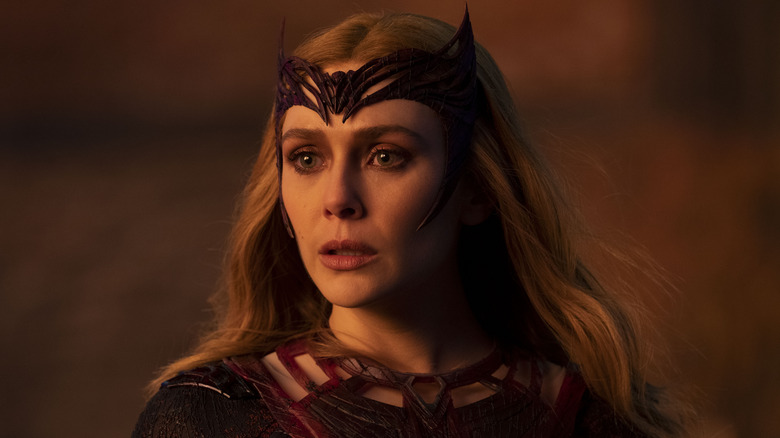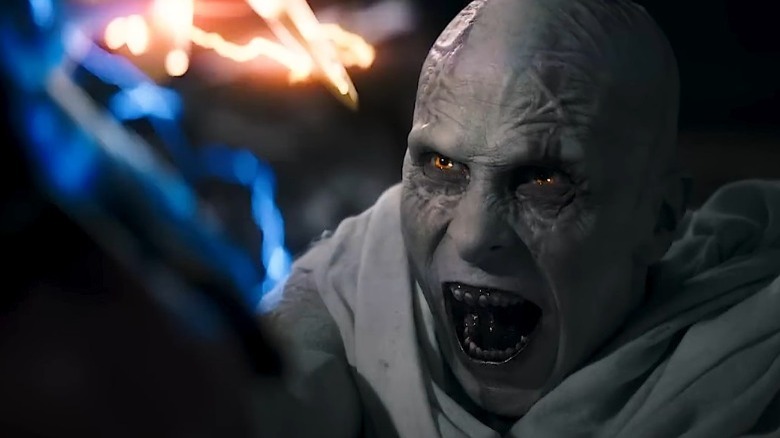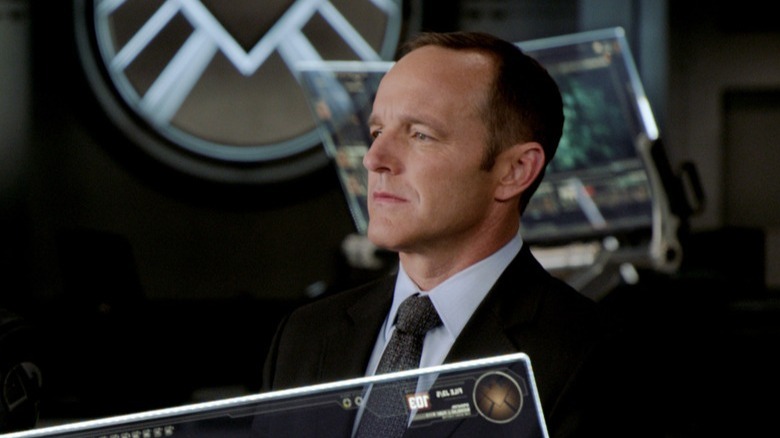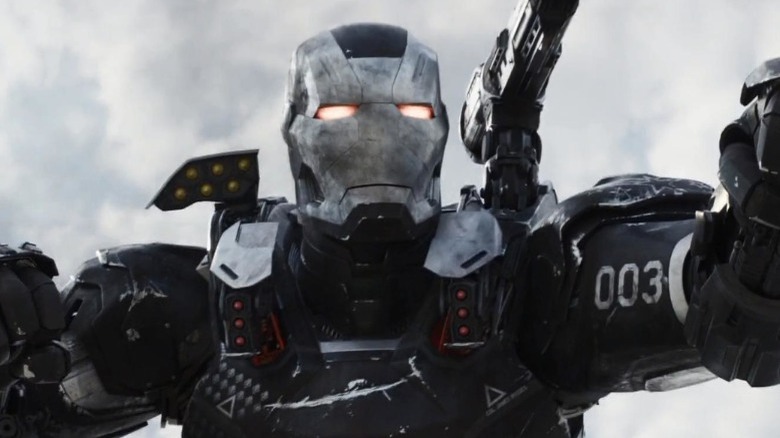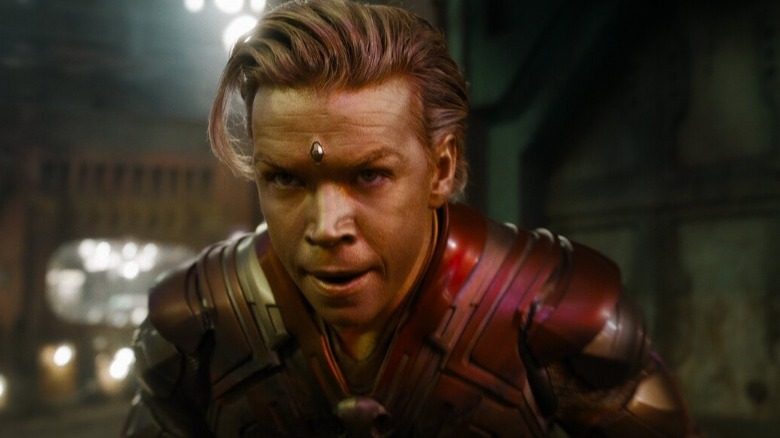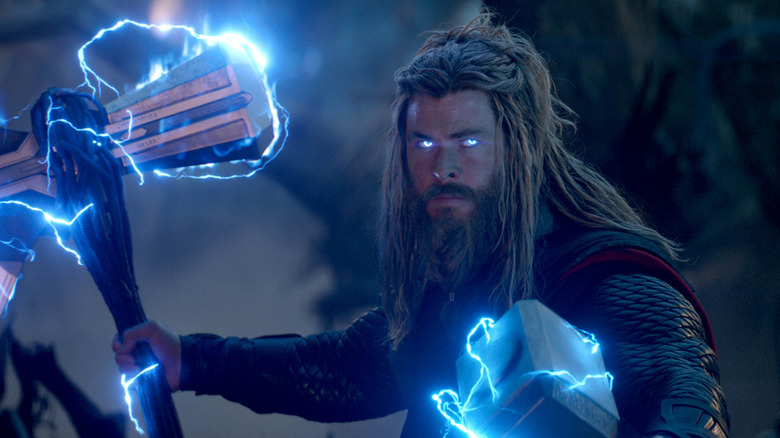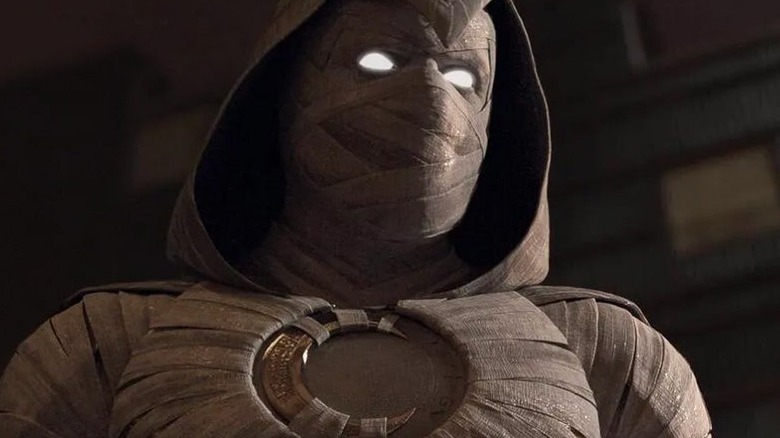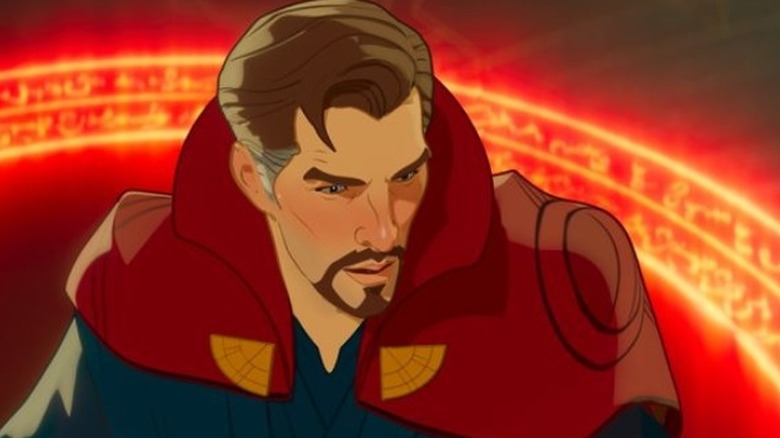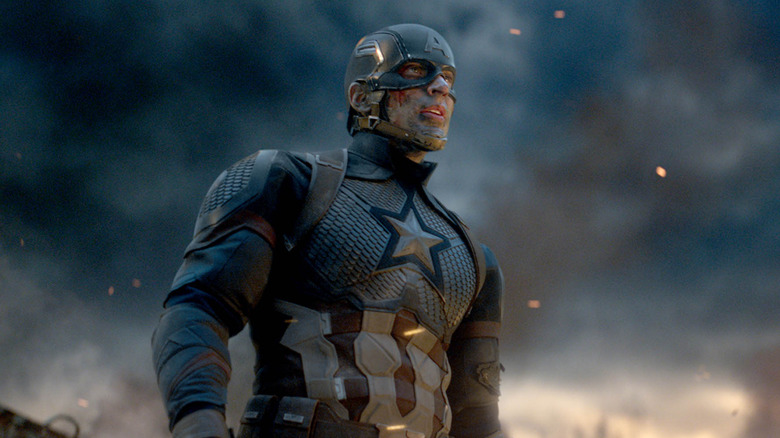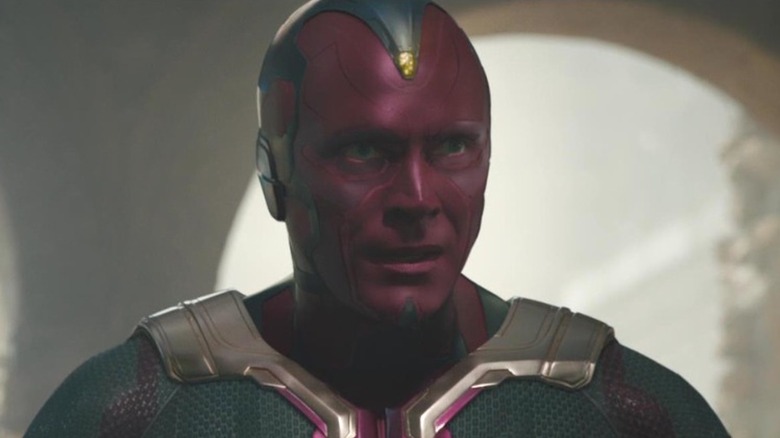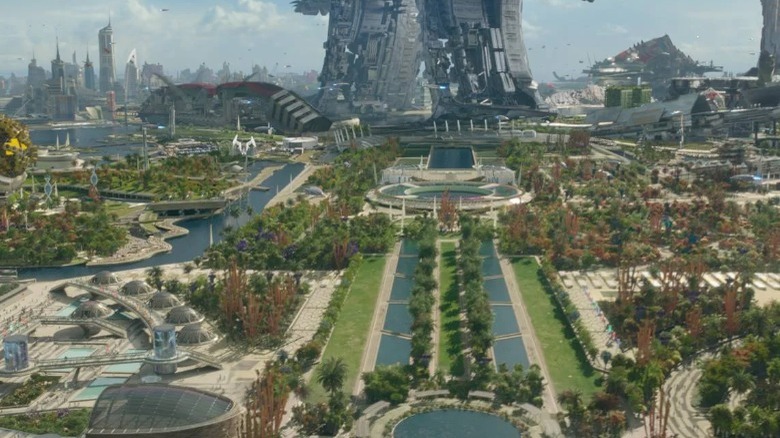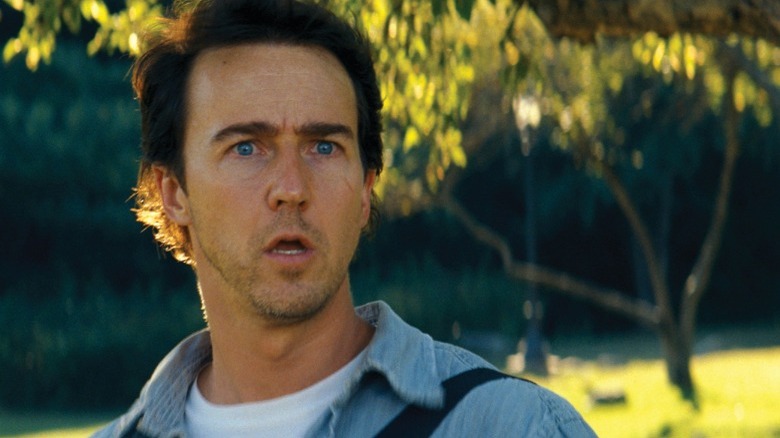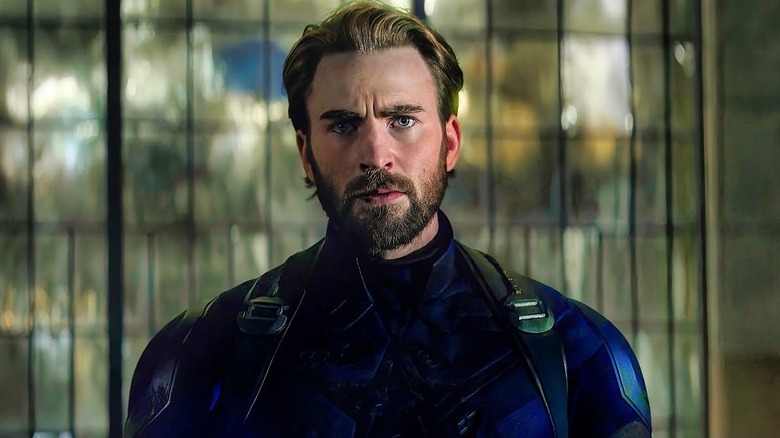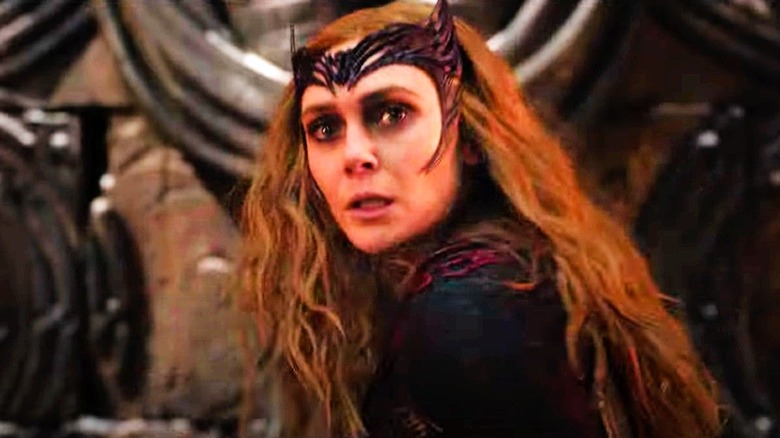R-Rated MCU Scenes Fans Will Never Get To See
The Marvel Cinematic Universe has always been a movie and television franchise that has largely shied away from any sort of mature material. That isn't exactly a huge surprise, given that the comic book adaptations are designed to appeal to as wide an audience as possible and are produced by Disney. While things are due to change in the near future with the release of "Deadpool 3" and "Blade," the Marvel series continues to be thoroughly family-friendly for the time being.
However, that doesn't mean that various writers, directors, and other filmmakers who have worked in the MCU haven't tried to include some darker content. Whether it's more violent battle scenes, abusive language, or even nudity, there have been some R-rated scenes that were originally intended to be part of the MCU but were removed for various reasons. You might actually be surprised to find that your favorite Marvel movies may have had these questionable moments as part of the story — if they weren't left on the cutting room floor instead.
Christian Bale almost pushed things too far in Thor: Love and Thunder
"Thor: Love and Thunder" could well have been even darker than it was. Christian Bale, who portrayed the villainous Gorr, told Inverse that he and director Taika Waititi wanted to push the limits as much as possible, even when they knew the action was unlikely to ever make it onto the screen. In some instances, fellow co-star Chris Hemsworth even thought they were going too far and worried that the scenes would only be appropriate for an R-rated release. However, Bale and Waititi wanted to explore as many possibilities as possible, although it is unclear exactly what these particular scenes were and there is little chance anyone will ever get to see them.
Bale said, "We kind of knew that some of the stuff we were doing probably wouldn't end up in the film, but we wanted to just push it and see. Ultimately, it is and should be a film that all the family can go and enjoy. And Chris Hemsworth, a couple of times he looked at me it was like, 'Dude, that's a little too far' ... but it was a great joy to give it a shot."
Coulson's death was even worse
Agent Phil Coulson may have only been a secondary character, but he played an important role during the early parts of the MCU. A longtime ally of Nick Fury and a leading member of SHIELD, he was a significant part of both "The Avengers" and "Agents of SHIELD," as well as the prequel film "Captain Marvel." Clark Gregg brought the character to life on screen in live-action and animated form, getting resurrected following his death in "The Avengers" at the hands of Loki.
While trying to escape the Helicarrier where he has been imprisoned, Loki stabs Coulson from behind with his scepter. It proves to be a pivotal moment, providing the necessary motivation to force the heroes to form the Avengers. However, early versions of the film were more gruesome than what was eventually shown.
In order to avoid an R rating, the filmmakers had to tone down this death scene to include less gore, and remove the end of the scepter from poking through Coulson's chest. "Well, whenever you impale somebody from their back and the blade comes out their chest, there are issues," Marvel Studios head Kevin Feige told Movies.com (via Digital Spy).
Rhodey being horrendously injured
With "Avengers: Infinity War" in full swing, Children of Thanos members Proxima Midnight (Carrie Coon) and Corvus Glaive (Michael James Shaw) attack Wanda (Elizabeth Olsen) and Vision (Paul Bettany) in Edinburgh to capture the Mind Stone. A battle quickly ensues as several members of the Avengers appear to help the two heroes. This includes Captain America (Chris Evans), Black Widow (Scarlett Johansson), and the Falcon (Anthony Mackie). The group manages to repel Thanos's operatives, rescuing Wanda and Vision.
The fight, though, was originally set to include another member of the Avengers. In the book "Avengers: Endgame — The Art of the Movie," designer Phil Saunders explained that the script saw James Rhodes (Don Cheadle) — otherwise known as War Machine — involved in the dramatic battle. His removal may well have been because at one point, one of the Children of Thanos would split Rhodey in two. Eventually, the camera would reveal Rhodes actually remotely piloting the War Machine suit, but that might not have been enough to lessen the shock of an apparent gruesome and rather sudden death. The writers ultimately removed the scene, as something similar happened in an earlier "Iron Man" film.
Adam Warlock had an explicit tirade in Guardians of the Galaxy Vol. 3
"Guardians of the Galaxy Vol. 3" pushes the envelope in terms of the kind of content usually associated with the MCU. The film featured some bloody, heart-wrenching deaths alongside plenty of violence, and even the MCU's first F-word. That makes a lot of sense, because James Gunn's series has always felt a bit more mature that other films in the overall franchise.
Despite all of that, some scenes were still removed from "Guardians of the Galaxy Vol. 3" to keep it from receiving an R rating. Chief among them was a moment with Adam Warlock (Will Poulter) and his mother Ayesha (Elizabeth Debicki). Speaking about the threat posed by the Guardians of the Galaxy, Warlock lets out an angry tirade, saying, "Do not fret mother, I will kill all your enemies for you ... I will. I will stomp on their skulls. I'm going to mush their brains between my fingers. I'm going to [expletive] on their bodies and make love to their carcasses."
There's no real indication about where the scene would have taken place, although it looks likely that it may take place after Warlock's initial attack on Knowhere at the start of the film. It's also not clear exactly why Gunn removed the rant, but an appeasement to the MPA's ratings board seems very possible.
Thor fighting children to get Stormbreaker
The official book "Avengers: Endgame — The Art of the Movie" delves into the creation of both "Avengers: Endgame" and the earlier "Avengers: Infinity War." There are also several stories about content that didn't make it into the films or were ultimately cut from the script before shooting began. A sequence that stands out in this regard is the story of how Thor, Rocket (Bradley Cooper), and Groot (Vin Diesel) acquire Stormbreaker. Author Eleni Roussos explains that the trio set out to retrieve the weapon from the skull of the gigantic World Serpent rather than having Eitri the Dwarf (Peter Dinklage) forge it for them.
But grabbing Stormbreaker is no simple task, with Thor and his allies, surrounded by decayed skeletons, forced to battle and kill the Serpent's terrifying children to escape. Visual development artist Rodney Fuentebella explained: "There was also an idea of how after they got Stormbreaker, as they were escaping, the children of the World Serpent would attack them, and they would have to fight their way out." It is little wonder that the filmmakers decided to go a different route.
A brutal Moon Knight versus Jackal fight
The MCU's television series might seem like an appropriate place to have some more adult content intended for mature audiences. After all, the shows featured on Disney+ don't have to be submitted to the Motion Picture Association for ratings and aren't broadcast on traditional television networks. However, that hasn't really been the case and it is clear that Disney wants to keep the MCU shows as family-friendly as possible – at least, for now anyway.
This thinking is evident from the way that certain content is missing from "Moon Knight." Despite some initial teases that suggested fans might get to see some of the MCU's most violent and bloodiest fights to date in the show, that wasn't actually the case.
In the first episode of the show, Steven Grant/Marc Spector (Oscar Isaac) battles one of Arthur Harrow's jackals. However, just as the action really begins, the camera pans to a hallway, leaving it up to the viewers to imagine what happens. It's a disappointing anti-climax, especially considering that it includes Grant's first transformation into his Moon Knight persona. Leaked footage of the choreographed fight during rehearsals indicates it would have been a brutal slugfest — but seemingly too violent for Disney to stream.
Doctor Strange's ultra-violent death
"Marvel's What If...?" series took a slightly different direction for the MCU. The animated show isn't considered canon and instead depicts alternate takes on established events, with certain characters and histories changed to show what might have been. One particular episode, titled "What If... Doctor Strange Lost His Heart Instead of His Hands?" shows what might have happened if Doctor Strange (Benedict Cumberbatch) had discovered time travel while learning the mystic arts, using the power to try and resurrect his dead girlfriend.
Throughout the episode, Strange becomes more deranged as Christine Palmer continues to die in spite of Strange's best efforts. When he starts to use the power of the Dark Dimension to aid his efforts, the Ancient One splits Doctor Strange into two individuals — essentially a good version that accepts his failure and an evil Strange that goes to even more extreme lengths.
Eventually, the villainous version absorbs the good Strange. In the original script, this scene would have been far more graphic. Showrunner A.C. Bradley wanted the evil Strange to beat the good Strange to death using the Eye of Agamotto, until the storyboard artists toned down the violence, which Bradley ultimately agreed with.
Thanos throwing Captain America's decapitated head
"Avengers: Endgame" pitted Thanos against almost every hero who appeared throughout the entire MCU franchise up until that point. In a climactic final battle, Thanos unleashes his true power and almost kills several important figures, using his strength and fighting ability to defend himself against all attacks. Even with all of the violence there isn't all that much gore, though the likes of Captain America and Iron Man (Robert Downey Jr.) certainly take a beating.
Speaking to EW, Anthony and Joe Russo explained how they had a plan to make this battle far more graphic than it appears in the final cut. As part of an original draft of the story, the directors wanted Thanos to appear in front of the assembled heroes and throw the decapitated head of a past version of Captain America in front of them — demonstrating just how far he was willing to go.
"We had most of the script working except for the third act, because Anthony and I were clinging to this concept that we wanted Thanos to walk up to the Avengers and throw Captain America's head on the ground," Joe Russo said. "We couldn't give up on it, and finally we said, 'All right, what if we don't do that, can we find another way into the third act?' And that's when it turned into what it is now."
Vision's naked introduction
Paul Bettany plays Vision in the MCU, a synthezoid first introduced in "Avengers: Age of Ultron" after Ultron creates an android body and J.A.R.V.I.S. has his intelligence implanted in it. The reveal that Vision is alive is a dramatic moment that, had Joss Whedon stuck to his original vision, may have caused quite a stir. Speaking to the "Lights, Camera, Barstool" podcast, Bettany gave the lowdown on the first plan.
"I know Joss Whedon apparently really, really wanted the rendition of him, when Vision first is born, before he was clothed," said Bettany.
After the effects team put together several samples for the director and others involved in the film to see, Whedon realized that this was not a direction they should go in. Few would argue that leaving out full frontal nudity, even if it was for an android, was likely the best choice for "Avengers: Age of Ultron" and the entire MCU at that time.
The destruction of Xandar
At the start of "Avengers: Infinity War," Thanos is already in possession of the Power Stone. The rare artifact was last seen in the MCU during the events of "Guardians of the Galaxy," when the heroes left it in the care of Xandar officials. During a later conversation, Thor confirms that Thanos decimated the planet to capture the Power Stone but the actual battle is not shown.
According to comics writer and Thanos creator Jim Starlin, in an interview with the web series "Near Mint Condition," this was not always the plan. In fact, the Russo brothers filmed a 45-minute sequence to appear at the start of the film showing the gritty reality of Thanos attacking Xandar. Considering the length of this deleted material, there's probably a lot of intense violence and death that didn't make it into "Avengers: Infinity War "
"There was a whole sequence of him getting the first gem and they had to cut that out," said Starlin. "They shot it, but they never wanted to spend the money on the effects and they didn't want the movie to be as long as the second one ['Endgame'] was."
Bruce Banner trying to end it all
"The Incredible Hulk," just the second entry in the MCU, was released in 2008 not long after "Iron Man." Yet it has always been an outlier in terms of its tone and the fact that Edward Norton plays Bruce Banner rather than Mark Ruffalo. The story begins with Bruce's transformation into the Hulk, after exposure to gamma radiation as part of a super soldier program that General Thaddeus "Thunderbolt" Ross (William Hurt) leads. The movie then jumps ahead years later, with Bruce hiding in Brazil to evade Ross and the U.S. military.
While "The Incredible Hulk" is a darker film compared to the rest of the MCU, the writers wanted to push this even further during the early stages of development. In the book "The Story of Marvel Studios: The Making of the Marvel Cinematic Universe" (via Screenrant), Marvel Studios VP of Production and Development Stephen Broussard details an alternative opening for the movie that saw Bruce trying to end his own life in the Arctic.
This is a hard topic to cover in a sensitive manner and having an important hero attempt to shoot himself right at the start of a film may have been too much for Marvel executives trying to establish a new franchise. The deleted scene is briefly alluded to in "Avengers: Age of Ultron," with Banner telling the rest of the Avengers about a time that "the other guy" spat the bullet out.
If you or someone you know is struggling or in crisis, help is available. Call or text 988 or chat 988lifeline.org
Cap bleeding into his food
Captain America has a rough time during the end stages of the Infinity Saga. Forced into hiding along with Black Widow and the Falcon after the events of "Captain America: Civil War," Steve Rogers spends his time away from most of the other heroes until they are called back into action to unite against Thanos.
"Avengers: Infinity War" co-writer Christopher Markus told IGN that the filmmakers planned to show the effects of Steve's new lifestyle during an early scene. While sitting with Black Widow and Falcon eating food, the bloodied and bruised trio are clearly struggling with everything that has happened. To demonstrate this in a truly graphic fashion, the scene depicted Captain America bleeding, with the blood dripping onto his food. Producer Kevin Feige eventually stepped in to have the scene removed.
Markus explained: "I remember Kevin [Feige] going 'He's bleeding into his mashed potatoes?! I don't want to see that!' Yeah, maybe we went a little too ... something."
Scarlet Witch holding a severed head
Of all the films in the MCU so far, "Doctor Strange in the Multiverse of Madness" is the closest the series has come to an R-rated movie. It includes lots of horror elements and graphic violence, especially in moments where the Scarlet Witch uses her full powers against her enemies. But one deleted scene in particular would have made things even more gruesome and probably ensured only adults could see it in the cinema.
The scene in question involves Wanda fighting with the sorcerers at Kamar-Taj. Fight coordinator Liang Yang posted footage on his social media showing rehearsals for a far more violent battle. In the video, the Scarlet Witch can be seen killing her opponents in much more horrifying and bloody ways, as the Avenger-turned-villain fully embraces her evil side. Perhaps the most macabre moment occurs when Wanda kills a version of Mordo from another reality and throws his severed head at Doctor Strange. That would almost certainly have earned the movie a R rating, given the rest of the questionable scenes already shown in the film.
